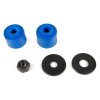And, the project gets closer to completion, due in good part to the help and info from members of this forum.
My son and I are down to the point of mounting the Predator 212 as a retrofit for the original H50 on this bike.
Based on the mock-up, we have to raise the front of the motor by 10mm and the rear by 35mm.
I was originally thinking of getting some aluminum block and milling it to a rough wedge shape, then drilling the holes.
While unable to sleep at 3AM, I started thinking about vibration isolation.
Any opinions on me just using rubber/poly sway bar link bushings (cut down) for the front spacers and some aluminum block PLUS some cut-down bushings for the rear spacers in order to dampen vibration a little?
My only concern would be making sure the engine couldn't "walk" in the mounting slots, but I'm sure I could figure a way to lock it in place.

My son and I are down to the point of mounting the Predator 212 as a retrofit for the original H50 on this bike.
Based on the mock-up, we have to raise the front of the motor by 10mm and the rear by 35mm.
I was originally thinking of getting some aluminum block and milling it to a rough wedge shape, then drilling the holes.
While unable to sleep at 3AM, I started thinking about vibration isolation.
Any opinions on me just using rubber/poly sway bar link bushings (cut down) for the front spacers and some aluminum block PLUS some cut-down bushings for the rear spacers in order to dampen vibration a little?
My only concern would be making sure the engine couldn't "walk" in the mounting slots, but I'm sure I could figure a way to lock it in place.




